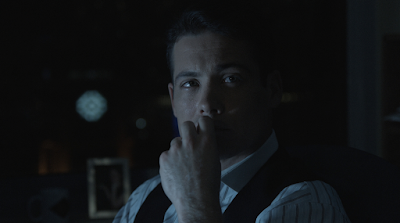By Elizabeth Belsky
Clark's timeline in FCPX
George Abbott Clark knows that Final Cut Pro X has a cloudy reputation in the editing business. “When it first came out, it was a nightmare,” he says on a phone call from Los Angeles. “But the new updates are remarkable. It’s like power steering - you would never go back to making it more complicated and cumbersome.”
In editing Jim Shoe from writer-director Pete Sutton, Clark faced pushback from post-production and industry peers in his choice to cut in FCPX. Amid a series of major studio releases also cut with the controversial program — Focus and Whiskey Foxtrot Tango among them — Clark remains steadfast in his adherence to FCPX, citing the ease of working with the system.
“[FCPX] has a rep for being simplified and dumbed-down,” Clark says. “But it’s not. It’s sophisticated, and advanced. There’s a misconception in the community.”
In the transition from FCP7 to X, Clark knew the new program was being built on a 64-bit platform from the ground up, making it much more stable than 32-bit based FCP7. While 7 was known for being unstable and prone to crashing with larger projects, he says that X nearly never crashes, even while editing natively in 4K. “You still must use proxy files for multi-cam, even with my high-end Mac Pro cylinder,” he says. “Time lapse can drop frames in 4k. But not if you use .MOV files and avoid Apple Pro Res 422 ‘optimized’ files on import.”
It’s worth pointing out that Clark is no stranger to doing things the hard way. As a bioarchaeologist, he received a Smithsonian Institute Fellowship after discovering a biological link between poor early growth and lifespan in the immune and neural systems, and earned a Ph.D from UMass Amherst. He segued into writing screenplays, earning a master’s degree in screenwriting from AFI, and eventually into editing. As one of a minority of editors working primarily on FCPX, his work has spanned both documentary and narrative projects, but he sees few major dissimilarities between the two genres.
“With a documentary, the main difference is that you sometimes don’t see what the story is until you’ve finished shooting,” he says. “You see the thread come together right in front of your eyes.” Clark served as a longtime editor, producer, and cinematographer on the documentary series Hooked on the Fly, which followed fly fishers through the ups and downs of their sport from Alaska to New Zealand. Clark cut all of Hooked on FCP7, citing the program’s organizational capacity, magnetic timeline, and the ease of its many shortcuts as upsides. “They take some getting used to,” he says. “It does have automated features, but you do have manual control as well.” He finds the FCPX interface and process to be faster and more intuitive than editing in FCP7.
Jim Shoe (2016) dir. Pete Sutton
With Jim Shoe, Clark worked with two 12-terabyte drives to organize his footage on his Mac Pro, as well as two 40-inch 4K displays. The film, which follows four attorneys competing for a partner slot through assigned, competitive pro bono work, clocked in at nearly nine terabytes as a finished project.
“The workflow did offer some challenges initially, because the post house didn’t know Final Cut X,” Clark admits. “They were all on Avid and Resolve, of course. We had to go back and forth between L.A. and Chicago, and it took hours to upload and download footage between us.” The film was colored and sound-mixed at Periscope Studios in Chicago, which was working on Premiere, Avid, and Resolve. Periscope needed OMF files for sound mix in ProTools, but because there is currently no direct way to export OMF files in FCPX, the challenge demanded a workaround. Instead, Clark used the app X2Pro to export AAF files from FCPX for use in ProTools. Clark then ran delivery tests with Periscope via DropBox, using 300 mbps Internet speed to quickly upload and share files with the post house. According to Abbot, “the test went perfectly.”
Another challenge presented itself during the coloring process, which was done in Da Vinci Resolve, by an Avid-trained colorist. “Importing went well, but we lost some stabilization,” Clark points out. Resolve has translated some elements of FCPX, but the process is currently far from complete. “Any time you rebuild a timeline from one editing platform to another, some things that were perfected get lost,” he says. “I hope Resolve and FCP keep closing the gap and talk to each other as Resolve continues to build out their editing functions.”
Jim Shoe (2016) dir. Pete Sutton
Through editing the film, Clark didn’t use keyword collections. “You have to come up with a much more intuitive way of organizing material,” he says. “I used keywords on a few things, to make sure I didn’t bypass certain formulas, but realized I really don’t need it.” Instead, he organized files by scene, by take, and by camera angle, then created multiple projects for each scene to provide options for the director. “One of the things I find helpful is having an MFA in screenwriting,” he says. “The editor isn’t just thinking about the cut, but you’re also thinking about story in a very deep way.” His background as both an editor and a serious writer gave him insight into editing alongside writer-director Pete Sutton, whose attachment to the material required some negotiation on certain cuts.
“Sight, sound, and story is what it’s about,” he says. “At the end of the day, you’re telling a story. You can’t let a lot of fancy editing get in the way. Form follows function.”



